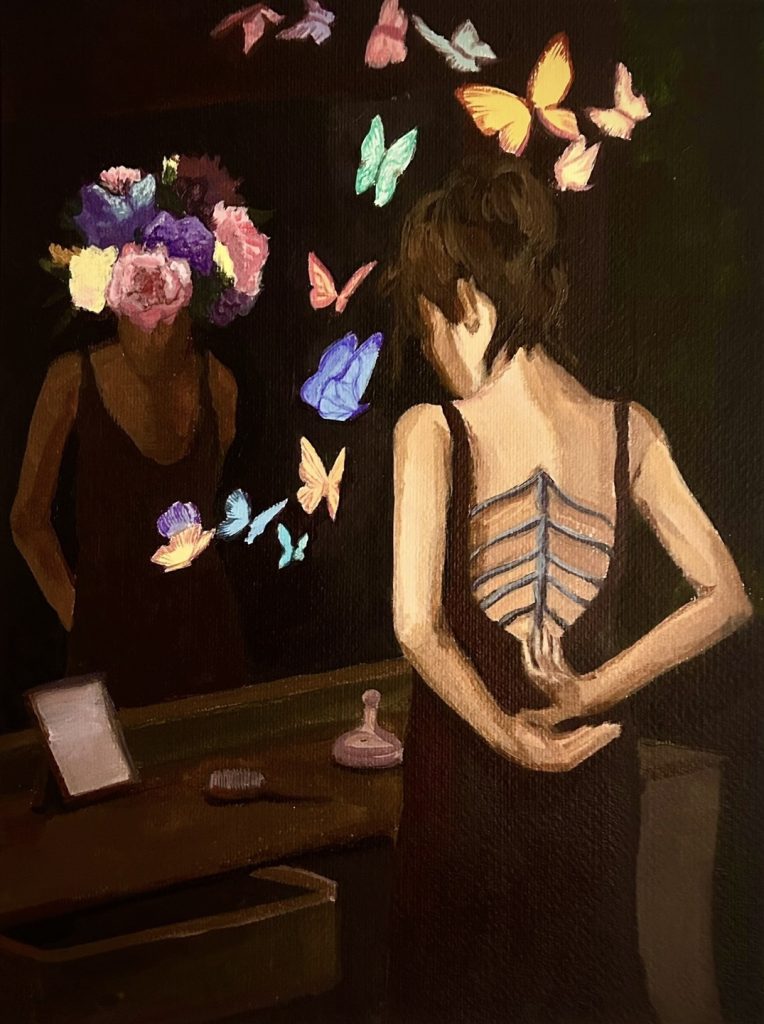Blend
A girl on the far left—
a cooling white sweater,
navy shorts that absorbed the salty texture of the sea
—raises her arm to shield her eyes from the glittering beam.
Ships fly across the waves,
seagulls float in the sky;
a brushstroke deeper,
layered in long tones of slate and teal.
The water moves with quiet muscle,
creases of white gathering near the shore
before breaking into lace at the toes
of seven figures drawn by tide—
some standing close where the water sighs,
ankles kissed by foam;
others linger just behind,
head slightly rested back, caressed by the soft ocean winds.
A few drift farther down the shore,
turned slightly, as if to say:
‘come see what the horizon hides.’
Three boys with their feet buried in the chilling sand,
one with a backwards hat, trying to fight the glaring gleam.
Two others play rock, scissors, paper
—their conversation captured in the pause between waves.
Sand, pale gold and warm with noon,
holds footprints like soft echoes.
The sun presses down,
gives the waves a shimmer that sings.
Light folds over each figure, placed precisely,
spaced like notes in a slow chord—
black shirts, white sleeves, a shoulder bare to the sun,
each color bleeding into the sea and sky.
Portraits Without First Chapters
The silence after a story that’s missing its end—
that’s how we meet them.
A pair of wrinkled hands, softened with time, already slower.
Their voices linger not in memory but in my imagination.
A train ticket with no date,
folded in a drawer beside war medals
and recipes written in a language,
we never learned to speak.
The note tucked into a borrowed book,
Laying neatly between pages of stories
flat, delicate, and fragile.
Maybe from someone they loved
before the word “family” included us—
a couple of letters to me,
a name I’ll truly never know.
We hold their endings like heirlooms,
guessing at beginnings.
Through photographs where they are younger
than we’ll ever know them to be.
A Childhood in Five Objects
Its fur dulled by the decade of sun,
ears bent from too many hugs,
eyes stitched with storied only I recall.
It once leaped from planets I drew in crayons,
spoke bedtime whispers only I could hear.
A stuffed rabbit slumps against the wall, now it waits—
from the last time, I tucked it in, quietly guarding retired dreams.
Where tea parties once were held.
Its patterns are now a faded trail,
stories of imagination yet more vibrant than
the wallpaper’s flowers ever dared to bloom,
echoes etched deeper than time could consume.
It has caught the weight of every goodbye—
To dolls, to friends, to phases passed.
Now it cradles still, but never forgets the shape of my steps.
Their spines creased with thumbprints of belief.
Each page reverberates my mother’s voice,
each character a mask she wore—yet all I remember is her.
Now they rest like loyal sentinels,
inked in the versions of me they kept,
a carpet lies bruised with soft indentations.
Framing skies that changed with my moods,
stormy eams, sunlit breaks, a single star I wished upon.
Four repeating seasons, every item slowly maturing with the age of time.
At night it played the moon’s lullaby,
by day, the chatter of birds on the branches.
Now it reflects back the outside world,
but never quite lets it in.
Warping my height as I grew each year,
Flashing glimpses of twirls, tears,
and the first stolen lipstick swipe.
Reflecting words mouthed in silence, a face rehearsed,
it now holds the quiet imprint of every version I’ve been.
Sally Lee is a student at an international school in Seoul, South Korea. Immersed in a multicultural environment, she draws inspiration from the diverse cultures and experiences around her. She is currently working on her writing portfolio.









